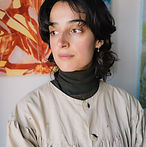
Beatriz Santos
Beatriz Santos is a London-based emerging artist who explores the relationship between poetic words and images.
Artist of the Month November 2024
Artist Profile
Artwork
On the occasion of ArtULTRA’s participation in the upcoming London Art Fair, our exhibiting artist Beatriz Santos discusses her practice with founder Alice Black. In the conversation, Beatriz reflects on her new series of paintings commissioned for the fair, the affinities and contrasts between her work and that of Christine Ankoua—whose paintings will be displayed alongside hers—and the challenges facing this generation of artists.
Beatriz Santos (b.1996, Lisbon) is a painter and printmaker based in London. Making paintings based on her own poetry, Beatriz often depicts everyday subject matter infused with lyricism. She explores decoration and affect using a multimedia approach of blending paper mâché frames, ornamental jesmonite sculptures, ceramic tiles, found objects and mural trompe l’oeil devices to unpack intimacy, humour, sadness and longing. Having completed an English BA at Clare College, Cambridge, Beatriz went on to study Art History at The Courtauld Institute of Art. Earlier this year Beatriz earned an MA in Painting from the Slade School of Fine Art, UCL. She is the winner of the 2023 Richard Ford Award and the 2024 Dolbey Travel Award.
Could you talk about your painting Prayer? What was the inspiration behind it?
B: Like the rest of my paintings from the series I’m showing at the London Art Fair, Prayer is inspired by a week spent in Rome with my family including my grandmother who is eighty years' old this year. The painting depicts a prayer alcove in St Peter's Basilica–the biggest church in the city and in the world in terms of interior space–and is inspired by seeing my cousin turn on an electric votive candle in a moment of reflection, following the death of her grandfather. The warm cadmium yellow which I’ve used as a ground is about contemplation, and it could also be interpreted as the glow of the candles.
In some of my paintings the figure is at the centre, but when the figure is off centre, like in Prayer, or disappears completely, it's the viewer who becomes the protagonist–I invite the viewer to step into the work. For this reason, I often enjoy guiding the viewer’s eye into my paintings by creating the suggestion of an interior beyond what is depicted, and allowing them to bring their own imaginative ideas to the piece.
There are two strong elements present in your paintings: your poetry and your close relationships with the people around you. Can you talk more about these two influences?
B: Writing poems to me is a way of organically coming up with certain images or sensory details that I remember, or half-remember from my life. I don't ever paint from an image and I don't take my own photographs–all my documentation is either in my mind's eye or in the fragments of poetry I write.
The lyrical quality of my poems is helpful as a source of inspiration because it make me feel like I can latch onto a specific image, mood or fleeting instance that will help me make a painting. The more I paint, however, I have a more flexible approach–I sometimes show a painting and a poem together, or start with a painting and write a poem to help me understand the painting more. I began painting for the London Art Fair as soon as I returned from Rome because I had the fantastic experience, and now that it has settled in my mind, I’m going to create poems inspired by making those paintings. While I enjoy the freedom of moving in between these two mediums, the reason I prefer to be a painter rather than a poet—though Frank O’Hara would say the opposite—is that painting has an immediacy that makes people feel welcomed. I'm dyslexic, so for me poetry only comes alive when it's read to me, or when I can listen to it via an audiobook and then it suddenly is activated - whilst a painting is always on, always waiting to immediately impact a viewer.
When it comes to the influence my relationships have on my painting, for me, it’s the people present in my life who are the most important form of inspiration I could have. It’s also a political question of who do I know well enough or have the right to represent, to capture their specific ways of being in the world. The way I approach painting people reminds me of the idea of a muse, but rather than having someone physically present as I paint, my subjects are my collaborators in my life who I draw inspiration from. I'm always troubled by how much I paint real people or if the figures are avatars for my internal moods or alter-egos: I guess I'm fascinated by how interrelational life as a human being is, and how the social and the individual overlap.
You just completed your MA at Slade. I wonder, how did it shape your practice?
B: Apart from the technical skills and contemporary art knowledge, I gained a lot of trust in myself—learning to own my emotions and to believe that my way of making art is valid and worth sharing. A lot of my work carries a sense of childishness, or elements of childhood and crafting–it's precious and clumsy at the same time, which I’ve come to embrace and which I think resonates with a lot of people. I think my wonderful tutors on the course encouraged me to get lost in paint - to really get close and intimate with my medium and to work intuitively with it rather than forcing anything. This has made painting really, really joyous and fun!









